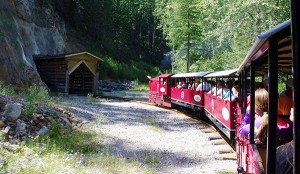Home »

Society preserves historical powerhouse
Restoration adds to visitor experience at Sullivan Mine
In a dark tunnel, a train comes to a halt; suddenly, a spotlight appears, and passengers watch as it settles on a miner at the rock face. He drills into the wall, recreating a scene from the historical Sullivan Mine before guiding visitors through a refuge station.
In its heyday, the mine featured 480 km of tunnels and 60 km of railway. Once the largest lead /zinc producing mine in the world, the former Sullivan Mine site now features Kimberley’s Underground Mining Railway, home of the Underground Interpretive Centre Tour. The popular interactive guided train experience takes visitors on a journey through the property and back in time. The most recently restored component on site—the powerhouse—will be unveiled when the exhibit opens this spring.
“We make history come alive; that’s what makes this exhibit unique,” explained Mick Henningson, Sullivan Mine & Railway Historical Society president and restoration project manager. “The powerhouse is special in that it’s historical, yet heavily visited today. Each season 10,000 people come through the doors, outside of a COVID-19 year.”
 When the mine was operational, the powerhouse supplied compressed air to underground equipment, as well as 300-volt DC power to the electric trains that transported ore, workers and equipment. Besides the huge original compressors and generators, it now stores artifacts and treasures, including a two-tonne high-grade ore sample that was originally exhibited at the 1967 World Fair in Montreal.
When the mine was operational, the powerhouse supplied compressed air to underground equipment, as well as 300-volt DC power to the electric trains that transported ore, workers and equipment. Besides the huge original compressors and generators, it now stores artifacts and treasures, including a two-tonne high-grade ore sample that was originally exhibited at the 1967 World Fair in Montreal.
While the 1924 structure is sound, the building needed repair and preservation. After securing funding, from Columbia Basin Trust, heritage professionals conducted a full assessment, developed a conservation plan and guided the Society in managing the retrograde, which was completed by local tradespeople.
The largest part of the job was restoring the 76-metre-long building’s 34 sets of windows, which consist of 3,200 panes of glass. In some instances, the windows had been removed entirely and boarded up with plywood, so tradesperson Tom Roberts completely restored the frames.
Riemann Painting employees undertook window restoration in hazmat suits due to lead paint and asbestos found in the original window glazing. During this extensive operation, the team literally saw a window of opportunity, and replaced an enormous 823-metre-long rope on a 125-year-old Rand compressor, which is a big draw when it’s fired up during the tour.
Mason Barry Bates painstakingly restored the exterior brickwork, repointing mortar and replacing missing bricks. Refurbishing the interior walls and flooring was a commercial-size endeavour of its own, also completed by Riemann Painting. The final result is an authentically revived building that is treasured by those who worked on it and by those anticipating their next visit.
“To see the powerhouse building in its new shape and to look at the before-and-after pictures is just tremendous; it’s incredible to see what we managed to accomplish,” said Henningson.
The exemplary work done on the site can be used as a case study for heritage professionals who work in hazmat and hazardous waste remediation. Heritage BC Planner Jennifer Dunkerson and Elana Zysblat, heritage consultant, were key to the restoration effort.
While contractors were hired for the project, which started in July 2019 and finished in November of 2020, it’s estimated that volunteer and in-kind donations saved approximately $50,000.
“We’re so fortunate the Trust funds valuable community projects here in the Basin,” added Henningson.
The 30-member society includes a variety of tradespeople devoted to maintaining the 7.5 km of track, four locomotives and eight passenger coaches transporting tourists throughout the May-to-September season. Twelve employees and several volunteers operate the site, which also includes free attractions like a replica of the city’s famous Orpheum Theatre, the 1902 North Star Schoolhouse, the Miner’s Cabin and a 1922 Canadian Pacific Railway caboose.
Discovered in 1892, the Sullivan Mine deposit was acquired in 1909 by the CP Rail-owned Consolidated Mining and Smelting Company of Canada (Teck). The mine’s economic success was mostly a result of the Company’s 1916 development of the differential flotation process, which allowed separate recovery of lead and zinc concentrates during the milling process.
The mine was in operation for nearly 100 years before officially closing in 2001, when the City of Kimberley pivoted from its mining roots to a thriving tourism economy. Henningson was actively involved in growing the community as a year-round tourist attraction.

“As a community-minded person that retired in Kimberley, I couldn’t just retire and go golfing and skiing all the time,” says Henningson, a former senior vice president at Teck. He was inspired to apply his project management skills to the non-profit organization and is thrilled to see the powerhouse so beautifully restored.
“It’s very satisfying to see it completed, and I look forward to showing it off in its restored state for years to come.”
Columbia Basin Trust supports the ideas and efforts of the people in the Columbia Basin. To learn more about the Trust’s programs and initiatives, and how it helps deliver social, economic and environmental benefits to the Basin, visit ourtrust.org or call 1.800.505.8998.
Columbia Basin Trust photos
Submitted by Columbia Basin Trust







